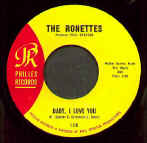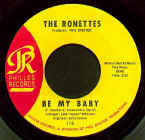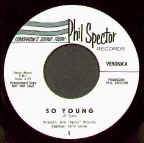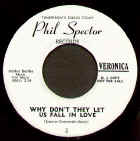The Ronettes
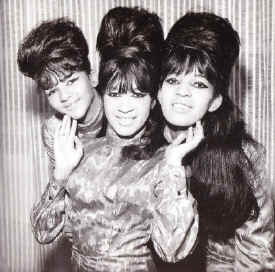
L-R: Nedra Talley, Ronnie Bennett, Estelle
Bennett
Perhaps the best remembered of the "girl group" of the
early '60s, The Ronettes achieved their biggest success under
producer Phil Spector. In towering black beehive hairdos and dark
eye makeup, the Ronettes were a classic mid-sixties girl group
with a sultry twist; vulnerable but tough, sexy but sweet.
Members:
(1961-1966)
Veronica (Ronnie) Bennett
Estelle Bennertt
Nedra Talley
Veronica (Ronnie) Bennett, her sister Estelle,
and their cousin Nedra Talley grew up in New York City's
Washington Heights listening to rock and pop, especially Frankie
Lymon and the Teenagers and Little Anthony and the Imperials.
Starting in 1959, their grandmother would
sequester the three in a room for an indefinite period and
encourage the three to harmonize.
The girls aged 13 to16, called themselves the
Darling sisters and took their act to the Apollo theatre amateur
contest. When they won Grandma started having them take singing
lessons. Phillip Halikus heard them, saw their potential and
became their manager. He started them out with appearances at
hops and charity shows.
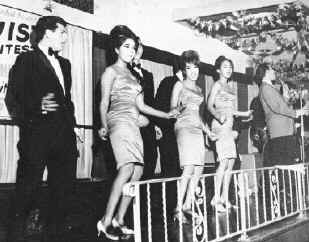
Clay Cole with the Ronettes dancing at the Peppermint Lounge
On night in 1961, the girls dressed in tight
skirts and with their hair piled high, stood in line at Joey
Dee's Peppermint Lounge on New York's 45th Street. the manager
mistaking them for a singing trio that hadn't arrived and took
them inside. Ushered them on stage and they belted out a version
of Ray Charles' "What I Say," even using the
choreography they had been working on. The girls took the club by
storm and were signed to appear regularly for $10 a night.
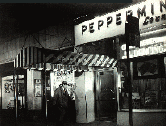
Photo courtesy Joey Dee's "Peppermint Twist"
Lounge
The Darling Sisters were also booked to perform
at the Miami Peppermint Lounge. There they were spotted by New
York disc jockey Murray Kaufman, who converted them into Murray
the K's dancing girls for his touring company and his Brooklyn
Fox shows. They also did duty with Clay Cole's
"Twist-A-Rama" tour.
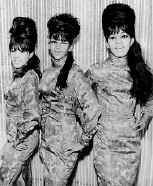
Meanwhile Phillip Halikus set up their first
recording session through Stu Phillips at Colpix Records. Colpix
renamed the trio Ronnie and the Relatives and issued their first
single in the summer of 1961, "I Want a Boy."
The next single "I'm On the Wagon,"
listed the girls as the Ronettes. They also recorded an LP's
worth of material for Colpix/May, but it wasn't released until
their glory days.
In early 1963 they did an Exciter-styled rocker
called "Good Girls" which showed continued recording
maturity and a developing sound.
Between their other activities, the girls found
themselves backing artists like Bobby Rydell, Del Shannon and
Joey Dee on record.
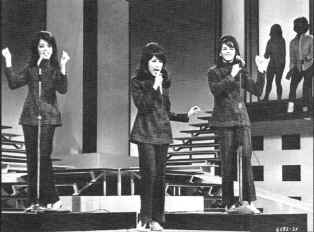
At 1965 The Big TNT Show
At this time there are two conflicting stories.
The first is that Estelle while dialing a phone number for
confirmation of a recording session, dialed the wrong number and
wound up talking to Phil Spector. One thing led to another and he
supposedly asked the group to do a demo for him. After hearing
them he wanted to immediately produce a Ronettes record. The
other less romantic version is that 16 magazine staffer Georgia
Winters introduced Spector to the girls while he was in New York
talent hunting. Whichever was true, Spector was taken with
Ronnie's hard but sweet sound and saw the "bad girls"
in beehives as an act he could build an image around.. Up until
that time girl groups rarely had an identity or even their
picures on the sleeves of their 45s. That changed with the
Ronettes.

The first single on Spector's Philles
label in July 1963 was a classic, the Barry/Greenwich/ Spector
"Be My Baby." Ronnie's distinctive, seductive vocal
delivery, along with her now legendary "woh-oh-oh-oh,"
drove teenage boys wild while Spector's production drove the
single to chart success. By October, 1963 it was at number two
and became an international hit as it reached number four on the
English Charts.
In November, earth shaking hand claps, thousand pound drums,
and Leon Russell's insistent piano playing, introduced the most
powerful wall of sound record yet "Baby I Love You."
the Ronettes held there own in a sea of orchestration, but not
without some support. Spector added the backing voices of Darlene
Love and the Blossoms, Ronnie herself, and Cher, over dubbing
them until he had twenty to twenty five voices, balancing out the
dense instrumental tracks. "Baby I Love You" charted on
December 21, 1963. Though it only reached number twenty four, it
went up to number eleven in Britain.

In November the Ronettes joined Dick Clark's Caravan of stars
and then returned to New York to record the memorable Christmas
album Spector's A Christmas Gift for You. The album's
rise to greatness was halted by the assassination of President
Kennedy.

With the Rolling Stones
(L-R) Brian Jones, Nedra Talley, Bill Wyman, Charlie Watts, Keith
Richards, Estelle Bennett, Mick Jagger
Front: Ronnie Bennett
With two hits in the U.K., the group flew to England in
February 1964 and toured with the Rolling Stones. While they were
there they met the Beatles.
That same month they released "The Best Part of Breaking
Up." It reached number thirty nine in the States and number
forty three in England before Spector returned to the high
powered teen rock with "I Do Love You," that had one of
the most power driven intros ever recorded. Despite only reaching
number thirty four in the US and thirty five in Britain, "Do
I Love You" was one of their best records.

1963, (L-R) Murray the K, Nedra Talley,
Ronnie Bennett, Estelle Bennett
When the Ronettes returned to the U.S., the Beatles were right
behind them, Murray the K, the self proclaimed fifth Beatle, met
them because of the Ronettes. During 1964, Spector test marketed
Ronnie as a solo act, issuing two singles under the name Veronica
on his label. the first was a remake of the Students' classic
ballad "I'm So Young" and a Barry/Greenwich/Spector
composition "Why Don't They Let Us Fall in Love," each
backed by the Ronettes and each pulled almost immediately after
release.
In November 1964, the Ronettes released "Walking In the
Rain," their most dramatic ballad. The Mann/Weil/Spector
written record reached number twenty three and won a Grammy for
Best Sound Effects, the only Grammy Spector ever received.
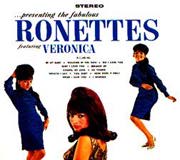
1965's "Born to Be Together" (#52) and
"Is This What I Get for Loving You (#25) were worthy of
greater response than they received.. Meanwhile, the Ronettes
backed up the Righteous Brothers' classic ballad "You Lost
That Loving Feeling." Their LP Presenting the Fabulous
Ronettes featuring Veronica only reached number ninety six though
it was the best Philles album.

Ronettes and Phil Spector
Spector's practice was to put an instrumental on the B side so
as to keep the disc jockeys from "flipping" the
record and taking attention from the A side. However, this wasn't
the case with the single "Is This What I Get"
which was paired with "Oh I Love You." This was the
last side that Spector produced with the Ronettes before he
married Ronnie in 1968.
In September 1966 Jeff Barry was given the reins for the only
non-Spector produced single on Philles (and their last Philles
forty-five) "I Can Hear Music."
By the end of 1966 the Ronettes had disbanded. Nedra married
WINS program director Scott Ross and Estelle married
producer/songwriter Teddy Vann. Ronnie forced into retirement by
Spector managed only to release an occasional single.

In 1971, under Spector's direction Ronnie recorded "Try
Some, Buy Some" for the Beatles Apple label. This was her
last charting record. It reached number seventy seven in the
spring of 1971.
In 1973, with her marriage almost over, Ronnie returned to
performing. She appeared as Ronnie and the Ronettes at Richard
Nader's "Rock and Roll Revival show at Madison Square
Garden. The new female trio included Denise Edwards and Chip
Fields.
In the fall Stan Vincent produced two singles of the new
Ronettes on the Buddah label; "I Wish I Never Saw the
Sunshine." This song was a re-recording of a song the
original Ronettes had recorded foe Spector in 1965. Spector
didn't release it until his 1976 Rare Masters LP came
out in the U.K.
In 1976 Ronnie sang backup for Bruce Springsteen at his New
York Palladium performance. This led to E Street Band member
Miami Steve Van Zant producing and arranging a 1977 single with
Ronnie Spector and the E Street Band titled "Say Goodbye To
Hollywood." The song written by Billy Joel, rocked with
Ronnie's most inspired vocals since the early Spector days..It
never charted.
In 1978 Ronnie tried again with a song called "It's a
Heartache" the record was beaten to the charts by Bonnie
Tyler's version (#3).
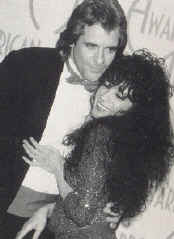
Eddie Money and Ronnie Spector
In 1980 rock and roll mover and shaker Genya Ravan produced
Ronnie on a fuzz toned wall of sound rocker called
"Darlin'" for her own Polish label. In 1986 she
recorded with Eddie Money "Take Me Home Tonight," which
put her back in the spotlight as it reached number four.
In 1987 Columbia issues a Ronnie Spector LP with the song
"Dangerous" backed up by the Bangles.

Through the eighties she performed as one of the
legendary ladies of rock and roll. December 11, 1990 CBS-TV aired
a special called "Grammy Legends" that included Ronnie
singing "Say Goodbye to Hollywood."
While the Ronettes were unique musically, they were also the
first really seductive girl group. Others before them seemed to
be singing to their friends about the boys they desired (
"Maybe" the Chantels; "I Met Him on a Sunday"
the Shirelles; He's So Fine" the Chiffons). The Ronettes
sang directly to the boys "Be My Baby," "Baby I
Love You") and performed to audience relations have never
been the same since.
Ronnie Spector died from cancer January 12, 2022 at her home
in Danbury, Connecticut.
Estelle Bennett died of colon cancer February 11, 2009 at her
home in Englewood, New Jersey.
The Ronettes were inducted into the Rock and Roll Hall
of Fame in 2007
The Ronettes were inducted into the Vocal
Group Hall of Fame in 2004







